This Year’s Garden Experiment: A Headless Chicken & The Great Guinea Massacre

Plan your best garden with simple, step-by-step instructions!
This post may contain affiliate links, which means I make a small commission at no extra cost to you.
See my full disclosure here.
Warning: The following tale is not for the faint of heart.
As you might have guessed from the title, it involves murdered birds and decapitated chickens. Blood and guts. Feathers and more feathers.
Nutshell Version
Here’s the nutshell version: Our dog ate four guineas and three chickens. It made us really mad. We had to get new guineas–which were expensive–and build strong gates.
Want all the details? Read on…
If you’ve been following along with our Garden Experiments (see the list at the end of the post), you know that we decided to take a rather extreme route in our organic battle against garden pests: We bought guineas.
Mr. Native Texan had planned to raise chicks with the boys, both for the fun of it and to add to our flock of three mature hens. It’s been so wonderful to have our own free-range eggs!
Organic Pest Control
As for the garden, chickens do help with bug control, but it’s not advisable to allow them free reign of a garden–they’ll eat the plants right along with the bugs.
Guineas, however, were reported to avoid the plants while decimating even the foulest of insects: squash bugs, stink bugs (and ticks). They require similar care to their cousins, the chickens, and are carried by our local feed store.
So we thought, Why not?
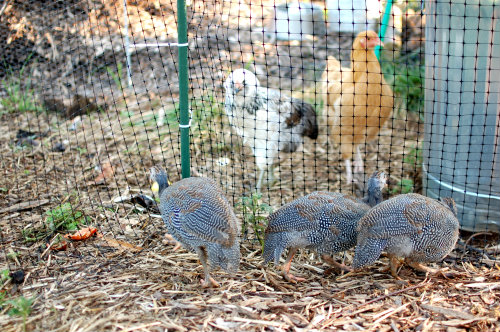
Notice the guineas in the foreground, inside the garden’s deer fence. The chickens patrol the perimeter of the garden, on the other side of the deer fence.
So Far, So Good
For many weeks, everything went great.
Mr. Native Texan fashioned two separate crates out in the shop: one for the chicks and one for the guinea keets. He and the boys fed and cared for them, and every single one survived the cold temperatures.

This is not a picture of our actual guinea brooding cage, but it’s the same general concept. Baby guineas look similar to baby chicks, but darker.
Photo credit
Side Note about Trooper the Weimaraner
Before I continue, let me provide a bit of background info for the main event of this story…
Our dog, Trooper, is a Weimaraner. Weimaraners are bird dogs.
You can see where this is going, right?
Trooper the Weimaraner often snatches doves out of the air, just for fun. He also regularly catches and eats mice, by the way. (Who needs a cat?)
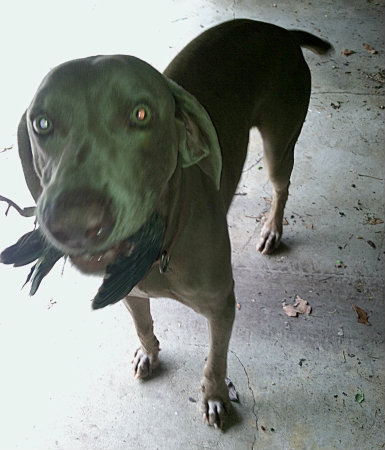
The quality of this phone photo is not great, but here is Trooper with a dove, snatched out of the air before our very eyes.
When we first moved to Virginia, we spent a few months living in an apartment while we house-hunted. Trooper lived with my folks on their farm in Pennsylvania, and during his stay went after a few chickens.
We knew all of this, and yet he had done so well with our three laying hens–leaving them alone while they roamed about. But trouble was brewing.
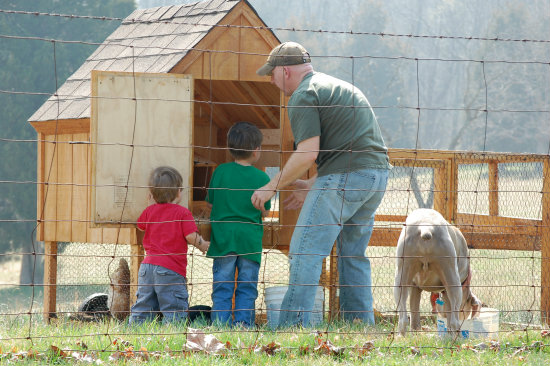
Several years ago, when we first got the chicken coop and our three original hens, Trooper did just fine with the girls. Little did we know what lay ahead…
First Casualty
First, he snatched one guinea keet when it popped up out of the cage as Mr. Native Texan was filling the feed dish.
One guinea down. Not a huge deal; we still had three guineas left, plus a bunch of adolescent chicks.
Second & Third Casualties
Not long after that, he somehow nabbed one of the growing chicks. They were almost full-grown by now, and had been moved outside to Chicken Coop #2.
Know how “we” discovered this bit of information? (And by “we,” I mean “I”.) Trooper left the dead chicken at the front door. {Ahem}
He’s done that before–apparently it’s bred into them. I myself discovered it at dinner time. Luckily, beef was on the menu that evening.
Shortly after, he nabbed another young chicken and brought it to Mr. Native Texan, who was working in the yard.
It was a definite setback, but at least we still had three guineas and five new chickens, plus the three older chickens.
The Great Guinea Massacre
Next, however, came an event so terrible, it’s taken me months to write about it.
One day, Trooper was inadvertently locked in the shop, after the boys had been playing outside. The same shop where the growing fowls were kept.
I realized a bit later that we’d never put Trooper back in the basement mudroom after our play time, and asked Older Brother to do so. We were eating lunch at the time, and Older Brother assured me he’d do it between lunch time and rest time.
As you might imagine, we both forgot all about it. And so Trooper remained in the shop for several hours.
I thought of it during rest time, but wanted Older Brother to follow through on his promise. Besides, the birds were all locked in their cages, safely out of reach of Bird Dog.
Well, when Older Brother came downstairs from rest time, I sent him out to the shop to release Trooper and take him down to the basement.
Older Brother returned a few minutes later, with a very strange look on his face. He sort of held up his hands and said “Um, there’s something strange out there.”
To sum it all up, somehow Trooper had gotten into the guinea cage. One guinea was completely MIA (want to guess where it went?) and the other two were smeared All. Over. The. Shop.
No more guineas.
No Mother-of-the-Year Awards Here
By the way, the conversation that followed on the heels of this event will not go down in the books as one of my Shining Moments of Motherhood.
And we won’t even talk about the conversation that ensued via cell phone with Mr. Native Texan. Let’s just say that I’m not a huge animal person, and Trooper has never been on my list of favorite beings.
But Wait, That’s Not All
Just a few weeks later, I came home one Saturday evening after running a few errands to find a headless chicken in the middle of the driveway. Seriously. Feathers and other parts everywhere.
I guess after getting a taste of all those guineas, he just couldn’t resist our original chickens.
A New System
So, although we briefly considered sending Trooper to live on the farm with my parents (and made the mistake of suggesting this out loud at dinner one night, at which point Older Brother dissolved into sobs and we abandoned the idea), in the end Mr. Native Texan got to work on a fencing system that still allows the chickens to free range a bit around the perimeter of the garden, while separated from the guineas who have free access to the garden.
And all of the birds are separated from the rest of the yard–and the Jaws of Death–by another fence. Which makes it a tiny bit complicated to get into the garden and the coops, but we’ve successfully avoided any further poultry losses.
And New Guineas
And by the way, although our local guinea keet season was over–i.e., there were no more baby guineas to be found at any local suppliers–Mr. Native Texan managed to track down three adolescent keets.
He had to drive quite a ways to retrieve them, and they all turned out to be roosters, and I never did find out how much he paid for them.
BUT they did their job in the garden, and we’ve learned a few lessons in the process.
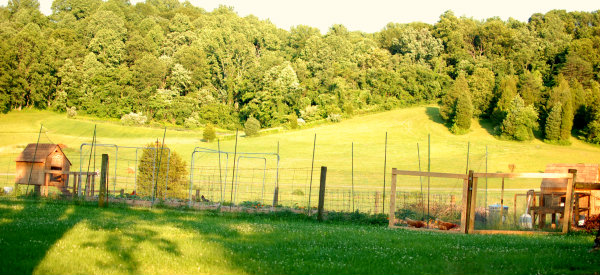
This is our garden–in early spring, before anything was growing. On the right are two new gates built by Mr. Native Texan–the left gate leading into the garden, which is surrounded by tall deer fence, and the right gate leading to the chicken coop. The gates are part of an exterior livestock fence, which sports chicken wire on the bottom half. Thanks to this new arrangement of fences and gates, our poultry population has remained stable, while still enjoying “free range” mobility as well as contributing to our organic pest control.
Hopefully next year we can avoid all this drama, and get right to the bug-eating, egg-laying part of raising poultry. 🙂
Catch up with the rest of This Year’s Garden Experiments:
- Sneak Peak: This Year’s Garden Experiment
- This Year’s Garden Experiments, Take Two
- Square Foot Gardening: How to Construct Sturdy, Economical Trellises for Climbing Crops
- This Year’s First Harvest
- Green Beans Galore
- Learning to Can (Can)
- Benefits of Using Herbs in Flower Arrangements
- This Year’s Garden Experiments: Organic Bug Control
skull and cross bones photo credit

Sign up NOW for my best tips delivered weekly to your inbox!
You’ll also get instant access to my library of free ebooks and resources.



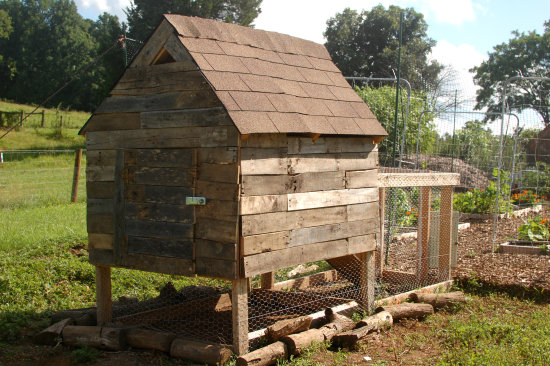



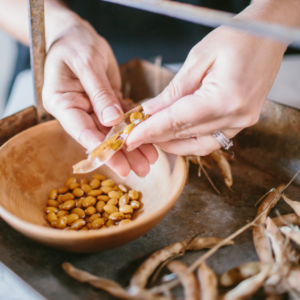
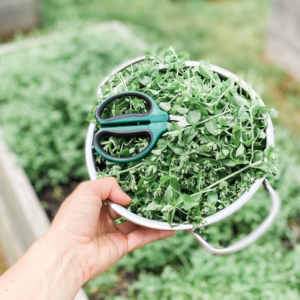
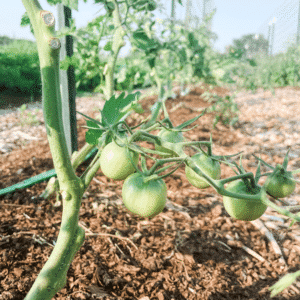
Oh my word! I’m sorry for the demise of your poultry population. But I have to admit I truly enjoyed reading your account. You should published this stuff in a magazine! You are a great journalist!
Thanks, Mom. 🙂
Oh my! That’s quite a story. How about a muzzle for trooper? 🙂
I’m with you, but am unfortunately outnumbered. 🙂
I really enjoyed reading your tale! I flip out when I know that there’s a little mouse in our kitchen trap. I don’t think I could have handled all of this.
Ha! We also regularly deal with mouse-in-the-trap, which I’m not fond of either. Thankfully, Older Brother has been trained on the proper procedure for trap-emptying. (For those times when Mr. NT isn’t available). 🙂